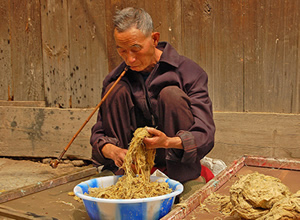News & Updates
Services
Asian Cultural Contributions - Paper

Miao man making paper from mulberry tree fibers.
In this corner of our newsletter we will be focusing on differing aspects of cultural contribution arising out of ancient Asia. We are choosing to initiate this series of articles by focusing on an item near and dear to us all-- paper…The Chinese culture is responsible for many important inventions throughout history, and paper, is probably the most widely used today.
If you happen to live near a paper mill, you might see the modern factories and think that the sheets of paper that we feed into copiers and write out our notes on, is a relatively modern invention. You may recall studying some ancient history and learning of the Egyptian’s use of papyrus, from which the word paper is derived. However, papyrus has almost no similarity to the paper that we use today.
Would you be surprised then to find out that essentials of the paper making process used today, (though adapted with more modern technology) has been around for nearly two thousand years? The first notation of the invention of paper was around 200 B.C. during the Qin dynasty. A courtier used cloth fibers to create the first paper. This paper was primarily used for wrapping up items, not for writing upon. Hemp fibers were used to make the paper.
Many other cultures were using various forms of material to write upon, but true paper used for writing, as we know it today, was invented by T’sai Lun or Cai Lun, an imperial courtier in the Han Dynasty. In 105AD, T’sai Lun is credited with using old rags and fishing net fibers to make paper. Later he improved the product by using mulberry tree fiber and other plant fibers to create paper. He described a method of papermaking that has been used right up to modern times. Throughout the world you will find craftsmen and artisans who still use his ancient method to create paper. It’s not as efficient or as productive as our modern day paper mills but it is still paper. Not until 610 AD did papermaking spread beyond China. In 610 AD it spread to Korea and then to Japan, by 750 AD to Central Asia, and Tibet.
It was the Arabian civilization that brought the process of papermaking to the Middle East in the late 8th century, and from there by the 13th century it had made its way to Europe. It is estimated that papermaking came to the US around 1690. In 1999, a scientist at IBM, T.J. Watson, called papermaking “the most important invention of the past two millennia.” (Paper Technology, March 1999)
If you would like to do a fun “project” with your child, you can try your hand at making your own paper at home! A couple of ways to do that are: you can purchase a paper making kit, or click here (http://www.pioneerthinking.com/makingpaper.html) to find instructions on how to build your own kit at home. Just think, you will be following a process that has sustained throughout the ages and it began in your child’s birth country!
 China Cell Phone Rental
China Cell Phone Rental Traveler's Checks and Currency Exchange
Traveler's Checks and Currency Exchange Travelex Travelers' Insurance
Travelex Travelers' Insurance China Visa Information
China Visa Information
